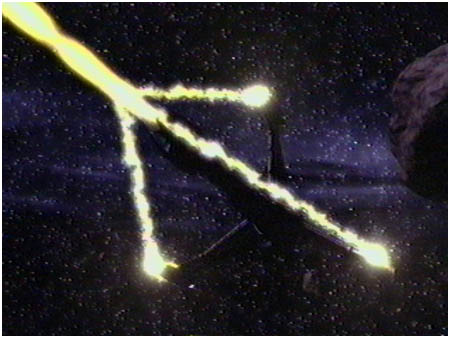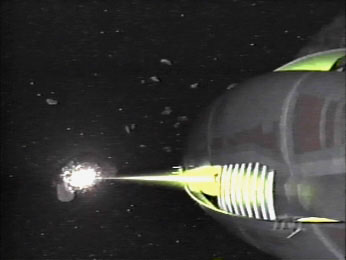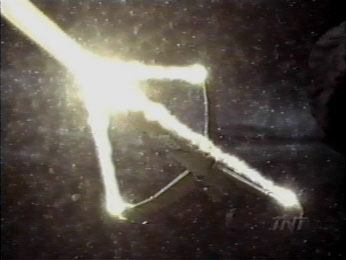![]()
|
||||
|
|
AVAILABLE DATA FOR EXCALIBUR
*Exclaibur's length of 2,990.31 meters was verified by Tim Earls - Visual Effect director for B5/Crusade - and is considered the cannon size figure for the Victory class Destroyer. Tim Earls statement overrides Gideon's comment that the ship was one and one quarter miles long, and fans have generally assumed that it was either a slip of the tongue and he meant to say "one and three quarter miles" or that he was talking about the ship's INTERNAL length, which would indeed be about 2000 meters.
Given that the beam went right though the Drakh Raider and the fact that Drakh vessels are not made of iron, this weapon is probably much more powerful than what is stated in the low-end figure. If the Drakh vessel is comprised of matterials as strong as those used by the Minbari, then the Quantum Discharge cannon would have to had fired a beam rated at no less than 4.7*1016 watt. Taking into account that the beam went right through the Drakh ship, her mass offering almost no resistance to the Excalibur's intense weapons discharge, it is likely that the average output of the Excalibur's secondary beam weapons is in excess of 1.0*1017 watt. Please note that the asteroid was not vaporized but disintegrated, the beam causing the asteroid to explode and fragment. Unfortunately, the scene doesn't offer much in the way of usable information, as we do not know exactly how much of the asteroid was destroyed by the beam and how much was destroyed by the thermal expansion and/or matter/antimatter reaction of the beam's impact. Still, the destruction of the asteroid as seen in "A Call to Arms" would be an order of magnitude below vaporization. At a mass of 6.296*1011 kilogram, and given the fact that to vaporization would require 7.8*106 joule per kilogram, it would have taken 4.91*1018 joule to bring the asteroid to vaporization. Consequently, a low-end estimate of the output of the Excalibur's weapons as seen in this scene, would have been approximately 4.91*1017 joule. This may not be a completely accurate estimate of this weapon's total output however, given the fact that Excalibur's engines - a key component required to make the weapon fully operational - was not functioning. Excalibur had to be toed out to the firing range by tugs, as seen in the TV movie and stated in the novel. It should also be noted that, in the novel, it was stated that the beam fired from the Excalibur did not act against the ship - there was no recoil. As a matter of fact, the "A Call to Arms" novel specifically stated that Excalibur was fitted with "recoilless gunnery" (pg. 68). In the episode "War Zone" the Excalibur fired on a Drakh Cruiser, which according to Tim Earls is 3,316 meters long... and he would know since Tim determined all the cannon sizes for the ships and vessels in the Babylon 5 universe. Beam went right through the damaged Drakh vessel in a hundredth of one second and continued on for several hundred more kilometers until the beam was out of sight. Given that the beam is approximately 235 meters in diameter, a volume of some 130 million cubic meters was instantly brought to its vapor point. Thus knowing this, we can calculate a more accurate lower limit to Exclaibur's main guns, as compared to the asteroid scene from "A Call to Arms." Adjusting for empty space, the total mass vaporized would have been roughly 52.05 million metric tons. If the Drakh vessel was comprised of iron, the total power required to accomplish this feet would have been 4.05*1017 watt, lending some support to the figure seen in "A Call to Arms." Unfortunately, the beam not only destroyed the damaged Drakh vessel, but went right through the Drakh Cruiser and kept on going until the beam was out of sight. This would suggest that the weapon firepower is at least an order of magnitude greater than the figure established above. For the sake of being conservative however, we will continue to only deal with the figures stated above. Drakh Cruisers are not made of iron of course, and their armor and technology (which is Shadow based), is superior to that of the Minbari. If their ships are constructed of matterial equal to that of the Minbari, estimated to be some 80 times stronger than our base matterial, then the total power required to blast through the Drakh ship would have been 32.5*1018 watt, or adjusting for the duration of the blast, a total beam discharge of 4.07*1021 joule. This figure corresponds to the total energy output figure based on the ship's time average reactor output, and as such we can assume that the ship's maximum beam output is in the range of 1.0 and 7.0*1021 joule. |
|||||


 *Low-End
figures for standard Quantum Discharge Cannons based upon the vaporization
of a Drakh Raider by this weapon in A Call to Arms. The Drakh
Raider is estimated to be some 215 meters in length, with a mass
of 75,510 metric tons. If comprised of iron, vaporization
point equals 7.8*106 joule per kilogram. Total
low-end energy required to bring Drakh Raider to vaporization would
be 5.9*1014 watt.
*Low-End
figures for standard Quantum Discharge Cannons based upon the vaporization
of a Drakh Raider by this weapon in A Call to Arms. The Drakh
Raider is estimated to be some 215 meters in length, with a mass
of 75,510 metric tons. If comprised of iron, vaporization
point equals 7.8*106 joule per kilogram. Total
low-end energy required to bring Drakh Raider to vaporization would
be 5.9*1014 watt. **Low-End
weapon output of main gun based upon the destruction of the asteroid
seen in "A call to Arms." The asteroid was destroyed within
a second upon impact. According to the novelization
the asteroid was about the size of a Whitestar (pg.
69), making it some 500 meters in length at it's longest
point, and no less than 400 meters at it's shortest, giving the
asteroid an estimated mass of no less than 629.6 million metric
tons. Given the asteroids light gray color, it was likely comprised
of stony iron and not a carbonaceous asteroid.
**Low-End
weapon output of main gun based upon the destruction of the asteroid
seen in "A call to Arms." The asteroid was destroyed within
a second upon impact. According to the novelization
the asteroid was about the size of a Whitestar (pg.
69), making it some 500 meters in length at it's longest
point, and no less than 400 meters at it's shortest, giving the
asteroid an estimated mass of no less than 629.6 million metric
tons. Given the asteroids light gray color, it was likely comprised
of stony iron and not a carbonaceous asteroid.